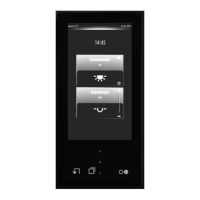Art. No. SC 1000 KNX
4.2.4.1.7 Channel function "Venetian blind/shutter (Position)"
With the channel function "Venetian blind/shutter (position)" it is possible to transmit 1-byte
position telegrams (values in compliance with KNX DPT 5.001 Scaling) to the bus. In this way, it
is possible to activate Venetian blinds (incl. slats) and roller shutters by means of position
values in combination with Venetian blind or shutter actuators. Similarly, other shading systems,
such as roof windows, vertical slats and awnings can also be controlled by individual
characteristics of the status indicators.
The difference between the channel functions "Venetian blind/shutter (Step/Move/Step)" and
"Venetian blind/shutter (position)" is in the data formats of the communication objects.
Just like a channel of the function "Venetian blind/shutter (Step/Move/Step)", a KNX channel
"Venetian blind/shutter (position)" can also be adapted to the type of shading system by the
ETS parameter "Shading". It is possible to configure "Venetian blinds" incl. slat control whereby
vertical slat systems are also controllable or alternatively "roller shutters" whereby window
drives or awnings are also controllable. To simplify the control, no slat functions are available in
the rolling shutter shading method. In this case, the selectable status icons are also adapted.
A KNX channel "Venetian blind/shutter (position)" for switching has a display element and
sensor surface in the graphic interface for operation. The display area and sensor area,
depending on the existing operation concept, are combined into one surface (direct operation)
or distributed on two surfaces (selection operation). The sensor element is always executed as
a rocker function and distinguishes between short and long operations.
A short sensor operation depending on the sensor surface Y / X (for a shutter/blind control) or
Z / ^ (for slat control) triggers value telegrams "100 %" or "0 %". In this way, the activated blind/
shutter or slats can be moved to the end position. Position value telegrams are transmitted to
the bus gradually in a defined time interval by means of long operations of the sensor surfaces.
The device then increases or decreases the value cyclically during the operation depending on
the value transmitter level configured in the ETS and transmits the values as a position setting.
The value sequence generated in this way is converted to a movement by the activated
Venetian blind or shutter actuator. The time between two value telegrams can be configured in
the ETS and must be attuned to the travelling time of the actuator channel as much as possible
in order to attain a movement operation as constant and interruption-free as possible.
The value transmitter level can be configured in the ETS to "not to be transmitted during
adjustment". In this case, the value adjustment is deactivated by a long button-press.
The time for short and long operations can be adjusted in the ETS as "time between short time
and long time command".
i In the display area, the channel in the "Venetian blind" shading method has up to two
status icons (slat status and blind/shutter status). Finger pressure on the status icons
influences the operation via the sensor surfaces and the representation of the operating
icons. If the slat icon was last pressed, the operating icons Z and ^ are displayed. This
should indicate the adjustment possibility of the slats by means of position setting. If the
Venetian blind/shutter icon was last pressed in the display area, the operating icons Y and
X are displayed. This indicates the adjustment possibility of the blind/shutter height by
means of position setting. Depending on this selection, position telegrams are either
transmitted to the bus via the object "Venetian blind slat position" or via the object
"Venetian blind position". The selection of the operating icons therefore influences the bus
telegrams.
Page 94 of 347
Software "Smart Control 501511"
Functional description

